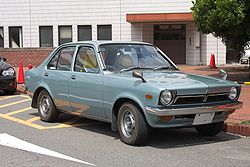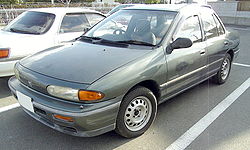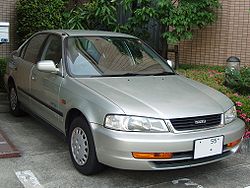- Isuzu Gemini
-
Isuzu Gemini 
Manufacturer Isuzu Motors Production 1974–2000 Assembly Fujisawa, Kanagawa, Japan Predecessor Isuzu Bellett The Isuzu Gemini was a compact car built, in several generations, by Isuzu and sold from 1974 to 2000. The same basic product was built and/or sold under several other names, sometimes by other General Motors brands, in various markets around the world.
Contents
1974
First generation 
Also called Isuzu Bellett Gemini
Isuzu I-Mark
Opel-Isuzu
Buick OpelProduction 1974–1984 Class Subcompact Body style 2-door coupe
4-door sedanLayout FR layout Platform T-body Related Chevrolet Chevette
Pontiac T1000
Holden Gemini
Isuzu Piazza
Opel Kadett
Vauxhall Chevette
Bedford Chevanne
Pontiac Acadian
Daewoo MaepsyThe first Gemini was the Bellett Gemini, first seen in November 1974. It was based on the third-generation Opel Kadett C on the General Motors T-car platform and came in four-door sedan and two-door coupe body styles. The chassis code was PF50, although the later 1.8 liter versions were called PF60 and the diesels PFD60.[1]
In June 1979,[1] the Gemini received a new slant nose with rectangular headlights and a redesigned rear end. The changes were actually more comprehensive than that, also including a redesigned (longer) engine bay and a wider radiator opening for two new engines added in November (the twin cam G180W and the new 4FB1 diesel) which both required wider radiators for more air for cooling.[2]
In Japan, sports models were available under the names ZZ/R, ZZ/T and ZZ/E. These were equipped with an Isuzu G180W 8-valve DOHC 1.8-liter engine, most commonly fuel injected, producing 97kW at the flywheel. These models also came with a shortened remote throw manual shift lever and optional factory LSD differential.
Isuzu Gemini was also sold in South Korea as Saehan Gemini, whose manufacturer became Daewoo Motors in 1982. It then became Daewoo Maepsy after 1982 and remained on sale (later as the Maepsy-Na) until it was replaced by Daewoo LeMans in 1986.
The Gemini was complemented in 1981 by the Giugiaro-designed Coupé Isuzu Piazza, based on the Gemini's platform, which was introduced in the United States in 1983 as the Isuzu Impulse and Australia in 1986 as the Holden Piazza.
In addition to sedan and coupe models, Holden in Australia produced the Gemini as a three door station wagon and three door panel van, which were derived from the Opel Kadett C Caravan and Vauxhall Chevette wagon, with Isuzu Gemini front panels. The Australian Holden Gemini was fitted with an Isuzu G161Z petrol engine, although 1979 and later models were available with a 1.8 litre 8 valve SOHC diesel engine (4FB1). The more common G161Z was a 1.6 liter 8 valve SOHC fed by a Nikki carburettor. The Holden Gemini was Wheels magazine's Car of the Year for 1975.
In Europe, the 1976 Gemini was equipped with a 1.3-liter engine known as the 1G13C, which was adopted by Opel in Germany for their Opel Kadett.
Sold as:
- 1975–1984 - Holden Gemini - Australia (1982–1984 in New Zealand)
- 1975–1983 - Opel Gemini - Malaysia, Thailand
- 1976–1979 - Opel Isuzu/Buick Opel - United States
- 1976–1982 - Saehan Gemini - South Korea ("Saehan Bird" in the export)
- 1983–1986 - Daewoo Maepsy/Maepsy-Na - South Korea, Saehan Maepsy before
- 1982–1988 - Saehan/Daewoo Max - pickup version, South Korea
- 1981–1984 - Isuzu I-Mark
1985
Second generation Also called Isuzu I-Mark
Chevrolet Spectrum
Geo Spectrum
Pontiac Sunburst
Chevrolet Gemini
Holden GeminiProduction 1985–1990 Predecessor Chevrolet Chevette (Spectrum)
Opel Isuzu (I-Mark)
Pontiac Acadian (Sunburst)Successor Isuzu Stylus (I-Mark)
Pontiac LeMans (Sunburst)
Geo Storm (Spectrum)Class Subcompact Body style 3-door hatchback
4-door sedanLayout FF layout Platform R-body Engine 1.3 L 4XB1 I4 (JT140, export only)
1.5 L 4XC1 I4 (JT150)
1.5 L 4XC1-T turbo I4 (JT150)
1.6 L 4XE1 DOHC I4 (JT190)
1.5 L 4EC1 diesel/TD I4 (JT600)Transmission 3-speed automatic
5-speed manualWheelbase 94.5 in (2,400 mm) Length I-Mark Hatchback: 157.9 in (4,011 mm)
I-Mark Sedan: 160.7 in (4,082 mm)
Spectrum Hatchback: 157.4 in (3,998 mm)
Spectrum Sedan: 160.2 in (4,069 mm)Width I-Mark: 63.5 in (1,613 mm)
Spectrum: 63.6 in (1,615 mm)Height I-Mark: 54.1 in (1,374 mm)
Spectrum: 52.0 in (1,321 mm)Designer Giorgetto Giugiaro General Motors sought a replacement for their world car T-body Kadett / Gemini, and this time, instead of building one design on several continents, they decided to build a world car in one location and export it to several continents. As a considerable portion of the T-body manufacturing had been turned over to Isuzu in Japan for economic reasons, so would the manufacturing of the replacement. In 1984, Isuzu again commissioned Giorgetto Giugiaro who was responsible for the 117 Coupe and the Piazza. This time, he was to design an economy car on the new front-wheel drive R-body platform. The R-body featured a MacPherson strut front suspension and beam axle rear suspension, which foreshadowed most of GM's offerings through their current model lineup. Giugiaro's design followed the Piazza design very closely in shape and detail, though the proportions made the Gemini appear shorter and taller in its three door version, and a four door sedan (notch back) was also designed.
Unfortunately for everyone involved, Isuzu presented the designs to GM prior to freezing them, and GM ordered a number of detail changes to them without ever consulting the designer, Giugiaro, which was taken as an insult, and ended the long relationship between the noted Italian designer and Japan's oldest car builder. The insult was serious enough to Giugiaro that he denied the design was his until a decade after the vehicle went out of production.
The R-body Gemini was introduced in May 1985 as the 'Gemini FF. In Japan, originally with chassis code JT150, it was available with a carburetted 1.5 liter SOHC engine. A newly developed 1.5 liter inline four diesel engine (JT600) was added to the lineup in November. At the other end of the lineup, a 120 PS (88 kW) fuel injected and turbocharged version of the 1.5 liter 4XB1 engine ("Irmscher") was added in May 1986. The FF Gemini underwent a facelift in February 1987, receiving a more aggressive front styling with wraparound headlight as well as other minor changes. At the same time the "FF" moniker was dropped, as parallel production of the preceding RWD Gemini came to an end. In March 1987 the Gemini saw its European premier, at the Geneva Salon. European sales of the already somewhat dated Gemini were disappointing, and Isuzu soon withdrew from the European passenger car market entirely.
A 1.6 liter DOHC engine with 135 PS (99 kW) was introduced in February 1988. Export versions were also available with a smaller 1.3 liter four to suit taxation systems based on displacement.[3] Trim levels were widely varied, from basic models ("C/C" in Japan, "LT" in general export markets, and "S" in the US) to Irmscher, ZZ, and Lotus Tuned versions, and plenty of optional equipment and dealer options were available.
North America
In the US, the vehicle was available from Chevrolet (and later Geo) as the Spectrum, or from Isuzu themselves, as the I-Mark. GM's Pontiac division sold the I-Mark as the Pontiac Sunburst in Canada from 1985 to 1988. GM Canada announced that the Sunburst's replacement would be the Passport Optima in 1989. For GM, this was an entry level vehicle to attract young buyers and to compete with Japanese compact cars in the US market. Chevrolet's Spectrum lacked many of the options and equipment of the I-Mark, though both were available with the 70 hp (52 kW) 1.5 liter SOHC non-turbo and 110 hp (82 kW) turbo engines, but no diesel engines were offered in the US. The turbo model I-Mark was called the RS model in 1988 and then changed to the LS model in 1989. The I-Mark was available with the 125 hp (93 kW) 1.6 liter DOHC engine in 1989 only, as the RS model. In 1988 and 1989, the LS and RS models were offered with Lotus Tuned Suspension, the sportier suspension featuring more rigid dampers, alternate spring rates, and bigger sway bars.
Sold as:
- 1985–1989 Isuzu I-Mark - United States
- 1985–1990 Isuzu Gemini - Japan, Europe, and Central America
- 1985–1988 Chevrolet Spectrum - United States & Canada
- 1989 Geo Spectrum - United States
- 1985–1989 Pontiac Sunburst - Canada
- 1985–1990 Holden Gemini - Australia
- 1985–1990 Chevrolet Gemini - Chile
1990
Third generation 
Also called Isuzu Stylus Production 1990–1993 Class Compact Body style 2-door coupe
3-door hatchback
4-door sedanLayout FF layout Platform R-body Transmission 3-speed automatic
5-speed manualWheelbase 96.5 in (2,451 mm) Length 165.0 in (4,191 mm) Width 66.1 in (1,679 mm) Height 54.1 in (1,374 mm) Related Geo Storm
Isuzu Impulse
Asüna SunfireThe Gemini was redesigned for 1990, and the coupe version was now renamed the Gemini Coupe. The last models were produced in 1993.
The Isuzu Gemini Coupe was the basis for the Isuzu Impulse and Geo Storm in the United States and Canada, and for the Asüna Sunfire which was sold for the Canadian market for the 1993 model year only.
A 4-door sedan with similar mechanical components was sold as the Isuzu Stylus in the United States and Canada. The Geo versions lacked some of the more expensive and advanced features of the Isuzu (and Asüna) versions.
All these variations were used on the last of the Geminis -- Isuzu Impulse, Isuzu Piazza, Isuzu Gemini MkII, Isuzu Stylus, and Asüna Sunfire.
1993/4
Fourth generation 
Production 1993–1996 Class Compact Body style 4-door sedan Layout FF layout Related Honda Civic
Honda Domani
Honda Integra
Rover 400Isuzu halted production of the Gemini and replaced it with a rebadged version of the Honda Domani.
1997
Fifth generation 
Also called Honda Domani Production 1997–2000 Class Compact Body style 4-door sedan Layout FF layout Wheelbase 103.1 in (2,619 mm) Related Acura EL
Honda Civic
Honda Integra
Rover 400
Honda CR-VThe 1997 Gemini generation was a rebadged Honda Domani sedan. Production of this model ended in 2000.
Safety
In Australia, the 1982–1984 Holden Gemini was assessed in the Used Car Safety Ratings 2006 as providing "significantly worse than average" protection for its occupants in the event of a crash.[4]
Related information
Isuzu Geminis and I-Marks were the most popular taxicab models in the Philippines in the 80s and early 90s. Models were phased out and gradually replaced with newer models from Toyota and Nissan.
References
- ^ a b (in Japanese) Car Graphic: Car Archives Vol. 11, '80s Japanese Cars, Tokyo: Nigensha, 2007, p. 239, ISBN 978-4-544-91018-6
- ^ Yamaguchi, Jack K. (1980), Lösch, Annamaria, ed., "Consummation of the Turbulent Decade", World Cars 1980 (Pelham, NY: L'Editrice dell'Automobile LEA/Herald Books): 66, ISBN 0-910714-12-6
- ^ Mastrostefano, Raffaele, ed (1990) (in Italian). Quattroruote: Tutte le Auto del Mondo 1990. Milano: Editoriale Domus S.p.A. pp. 388–390.
- ^ [1][dead link]
External links
- OzGemini.com
- HoldenGemini.net
- CanberraGeminiClub.com
- GemiSA Car Club (previously Just Gems of SA)
- Used Car Safety Ratings - Holden Gemini - Australia Only
- ISUZU Gemini Ads
Type 1980s 1990s 2000s 0 1 2 3 4 5 6 7 8 9 0 1 2 3 4 5 6 7 8 9 0 1 2 3 4 5 6 7 8 Subcompact car I-Mark I-Mark Compact car Impulse Impulse Stylus Compact SUV VehiCROSS Amigo Amigo / Rodeo Sport Rodeo Rodeo Mid-size SUV Axiom Trooper Trooper Trooper Ascender Minivan Oasis Pickup P'up Pickup Hombre i-Series Geo, a division of General Motors, automobile timeline, 1989–1997 Type 1980s 1990s 9 0 1 2 3 4 5 6 7 Subcompact Metro Metro Spectrum Compact Prizm Prizm Sport compact Storm SUV Tracker « previous – Chevrolet, a division of General Motors, road car timeline, United States market, 1980s–present Type 1980s 1990s 2000s 2010s 0 1 2 3 4 5 6 7 8 9 0 1 2 3 4 5 6 7 8 9 0 1 2 3 4 5 6 7 8 9 0 1 2 Subcompact Sprint Geo Metro Chevette Aveo Sonic Spectrum Monza Nova Compact Prizm Volt Cavalier Cavalier Cavalier HHR Citation Cobalt Cruze Mid-size Malibu Corsica / Beretta Malibu Malibu Malibu Celebrity Lumina Lumina Full-size Impala Impala SS Impala Impala Caprice Caprice Caprice Personal Monte Carlo Monte Carlo Monte Carlo Monte Carlo Sports Camaro Camaro Camaro Camaro Corvette Corvette Corvette Corvette Categories:- Isuzu vehicles
- Front wheel drive vehicles
- Rear wheel drive vehicles
- Subcompact cars
- Compact cars
- Coupes
- Hatchbacks
- Sedans
- Vehicles introduced in 1974
- 1970s automobiles
- 1980s automobiles
- 1990s automobiles
- 2000s automobiles
- Geo
Wikimedia Foundation. 2010.








